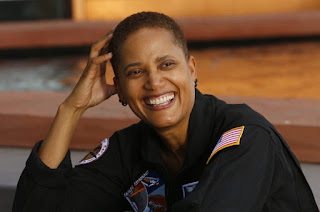AAS Committee on
the Status of Women
Issue of September 24, 2021
eds: Heather Flewelling, Nicolle Zellner, Maria
Patterson, Jeremy Bailin, and Alessandra Aloisi
[We hope you all are taking care of
yourselves and each other. --eds.]
This week's issues:
 |
| Sian Proctor. NASA photo. |
1. Crosspost: Sian Proctor makes history
with SpaceX's Inspiration4 as first-ever Black female spacecraft pilot
2. Astronomers for Planet Earth: Jessica
Merritt Agnos
3. FAMOUS Travel Grants to Promote
Diversity at AAS Meetings
4. Status of STEM in Europe
5. Jobs
of the Future: How to Use Today’s Skills for Tomorrow’s Industries
6. Job Opportunities
7. How
to Submit to the AASWomen Newsletter
8.
How to Subscribe or Unsubscribe to the AASWomen Newsletter
9. Access to Past Issues of the AASWomen Newsletter
-------------------------------------------------------------------------------
1. Crosspost: Sian
Proctor makes history with SpaceX's Inspiration4 as first-ever Black female
spacecraft pilot
From: Bryne Hadnott via womeninastronomy.blogspot.com
By Chelsea Gohd for space.com
Sian Proctor is making history as the
first-ever Black female spacecraft pilot.
Proctor, a geoscientist, artist and
science communicator, has been paving the way in the space sector for decades.
Now, years after being a finalist in NASA's astronaut candidate program back in
2009, she is realizing her dream of becoming an astronaut as she launches to
orbit with the Inspiration4 mission tonight (Sept. 15).
While the mission itself is making history
as the first all-civilian mission to launch to orbit, Proctor is accomplishing
a major first herself as the first Black female spacecraft pilot.
Read more at
http://womeninastronomy.blogspot.com/2021/09/crosspost-sian-proctor-makes-history.html
-------------------------------------------------------------------------------
2. Astronomers
for Planet Earth: Jessica Merritt Agnos
From: Bryne Hadnott via womeninastronomy.blogspot.com
This feature is part of our ongoing series
about the amazing women at Astronomers for Planet Earth (A4E), a global network
of astronomers and astronomy enthusiasts dedicated to offering their unique
perspective to the fight for climate justice. For this post, we'll hear from
Jessica Merritt Agnos, a graduate student studying astrophysics at San
Francisco State University (SFSU) with a background in communications and film
production.
Read more at
http://womeninastronomy.blogspot.com/2021/09/astronomers-for-planet-earth-jessica.html
-------------------------------------------------------------------------------
3. FAMOUS Travel
Grants to Promote Diversity at AAS Meetings
From: Camillia Freeland-Taylor via the AAS
News Digest
The FAMOUS (Funds for Astronomical
Meetings: Outreach to Underrepresented Scientists) Travel Grants program offers
opportunities for AAS members to secure funding to travel to a Society meeting
in order to increase the number of astronomers from historically
underrepresented groups, which is part of our mission.
FAMOUS grants will be awarded at a level
of up to $1,000 to attend a single AAS meeting, at which the awardee will
present their research. The proposal deadline is October 15.
Learn more at
https://aas.org/posts/news/2021/09/famous-travel-grants-promote-diversity-aas-meetings
-------------------------------------------------------------------------------
4. Status of STEM in Europe
From: Stefi Baum [stefi_baum_80_at_post.harvard.edu]
and Sukanya Chakrabarti [chakrabarti_at_astro.rit.edu]
Several resources are available to learn
about the status of women in science, technology, engineering, and math fields outside
of the United States.
A presentation for the next generation and
how they can learn to help each other, including a pdf of the slides, can be
found at
http://www.nccr-must.ch/nccr_must/news_4.html?5031
A talk that addresses both science and
gender with some personal experience, including a pdf of the slides, can be
found at
http://www.nccr-must.ch/nccr_must/news_4.html?5020
-------------------------------------------------------------------------------
5. Jobs of the Future: How to Use Today’s
Skills for Tomorrow’s Industries
From: Nicolle Zellner
[nzellner_at_albion.edu]
The American Association of University
Women has published an article that describes three ways recent graduates can
prepare to search for a job during the post-COVID recovery: be ready to pivot,
invest in learning new skills, and stay positive.
Read more at
https://www.aauw.org/resources/career/boost-your-career/job-skills/
-------------------------------------------------------------------------------
6. Job Opportunities
For those interested in increasing excellence
and diversity in their organizations, a list of resources and advice is here: https://aas.org/comms/cswa/resources/Diversity
-
Tenure-track
Astronomer, California State University Long Beach
http://tinyurl.com/p5tsft65
-
Tenure
Track Professor, Planetary Geoscience, University of Iowa
https://jobs.uiowa.edu/faculty/view/74285
-
Post-doctoral
Research Associate: Future Faculty Fellowship, Princeton University
https://puwebp.princeton.edu/AcadHire/apply/application.xhtml?listingId=21901
-
Lowell
Observatory Prize Postdoctoral Fellowship Program, Massachusetts
www.lowell.edu/careers
-
Postdoctoral
Opportunities, Center for Cosmology and Particle Physics at New York University
https://cosmo.nyu.edu/index.php/opportunities/
- PhD
Positions in Solar System Science, Göttingen, Germany
https://www.mps.mpg.de/phd/applynow
-------------------------------------------------------------------------------
7. How to Submit to the AASWOMEN
newsletter
To submit an item to the AASWOMEN
newsletter, including replies to topics, send email to aaswomen_at_aas.org
All material will be posted unless you
tell us otherwise, including your email address.
When submitting a job posting for
inclusion in the newsletter, please include a one-line description and a link
to the full job posting.
Please remember to replace
"_at_" in the e-mail address above.
--------------------------------------------------------------------------------
8. How to Subscribe or Unsubscribe to the
AASWOMEN newsletter
Join AAS Women List by email:
Send an email to aaswomen_at_aas.org. A
list moderator will add your email to the list. They will reply to your message
to confirm that they have added you.
Join AAS Women List through the online
portal:
Go to https://lists.aas.org/postorius/lists/aaswlist.lists.aas.org and enter the
email address you wish to subscribe in the ‘Your email address’ field. You will
receive an email from ‘aaswlist-confirm’ that you must reply to. There may be a
delay between entering your email and receiving the confirmation message. Check
your Spam or Junk mail folders for the message if you have not received it
after 2 hours.
To unsubscribe from AAS Women by email:
Send an email to
aaswlist-leave_at_lists.aas.org from the email address you wish to remove from
the list. You will receive an email from ‘aaswlist-confirm’ that you must reply
to which will complete the unsubscribe.
Leave AAS Women or change your membership
settings through the online portal:
Go to https://lists.aas.org/accounts/signup to create an
account with the online portal. After confirming your account you can see the
lists you are subscribed to and update your settings.
--------------------------------------------------------------------------------
9. Access to Past Issues
https://aas.org/comms/cswa/AASWOMEN
Each annual summary includes an index of
topics covered.












